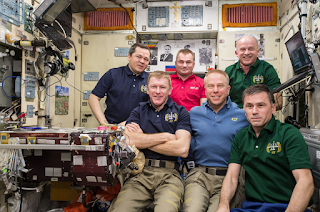The expansion of the BEAM test module over time. Credit: NASATV.
It took a little longer than expected, but the BEAM expandable habitat module has been finally extended and inflated. The BEAM (Bigelow Expandale Activity Module) arrived on the SpaceX Dragon flight which docked with the station back on April 8th. A week later, astronauts used the CanadArm robotic arm to remove the module from the Dragon and attach it to the US Harmony module airlock. A month later, it was time to begin the process of expanding the module. There were doubts at first that everything would go right, because the module was late getting to the station and had sit on Earth in its compacted form for longer than expected.
Location of BEAM and other docked spacecraft on the ISS. Credit: NASA.
Last week astronaut Jeff Williams began to slowly bleed air into the bladders that are located in the expandable skin. It was feared by engineers that if they had used the air reservoirs inside the BEAM to inflate the structure, the procedure would go too fast and cause damage. Williams used air from the station itself to fill the bladders slowly. Trouble showed up when indicators failed to show that the straps holding the module in its compact form had failed to release. The expansion was temporarily halted to investigate the situation and determine that yes, the strap had actually released. Williams and the ground engineers took deliberate time-outs to evaluate the situation after several slow sessions of introducing air into the bladders. Slowly, over tow days, as the structure expanded they became more confident and allowed the module to expand much faster.
Once the expansion was completed, Williams began to use the module air reserves to pressurize the interior of the module. When that is complete, there will be an 80-hour period of watching the sensors and indicators before the hatch is actually opened and astronauts will be allowed to enter.
You can read more about the operation on NASA Spaceflight: https://www.nasaspaceflight.com/2016/05/iss-inflatable-module-beam-expansion/








